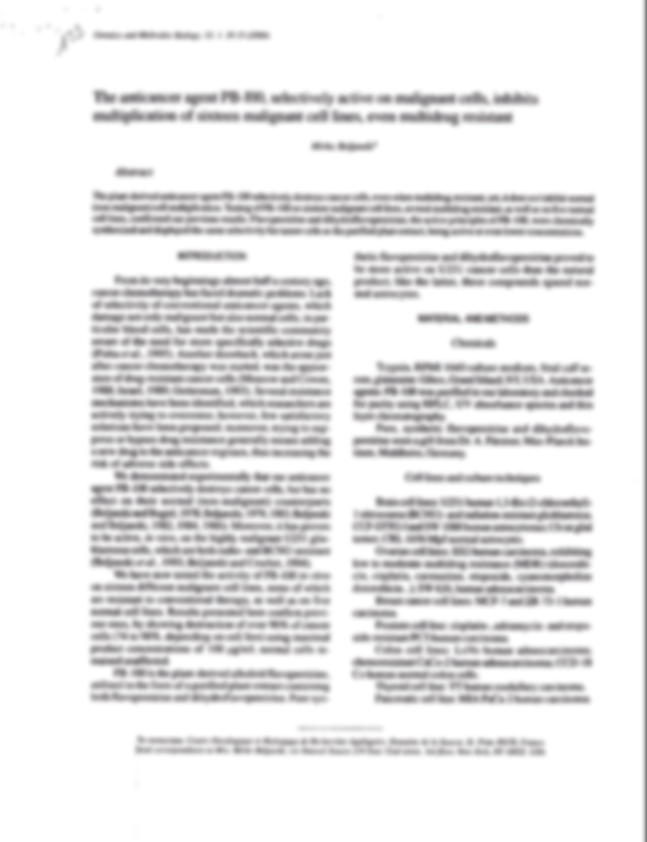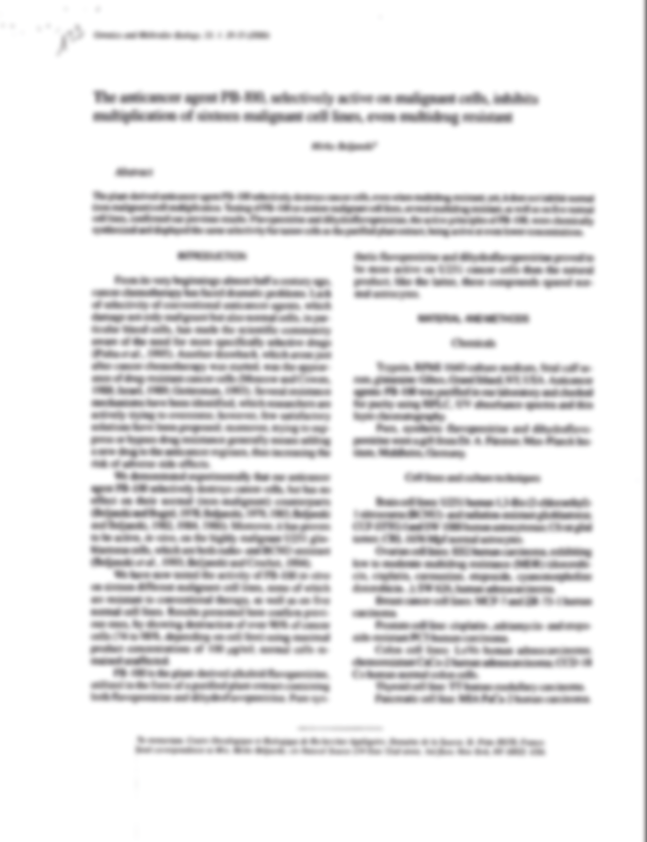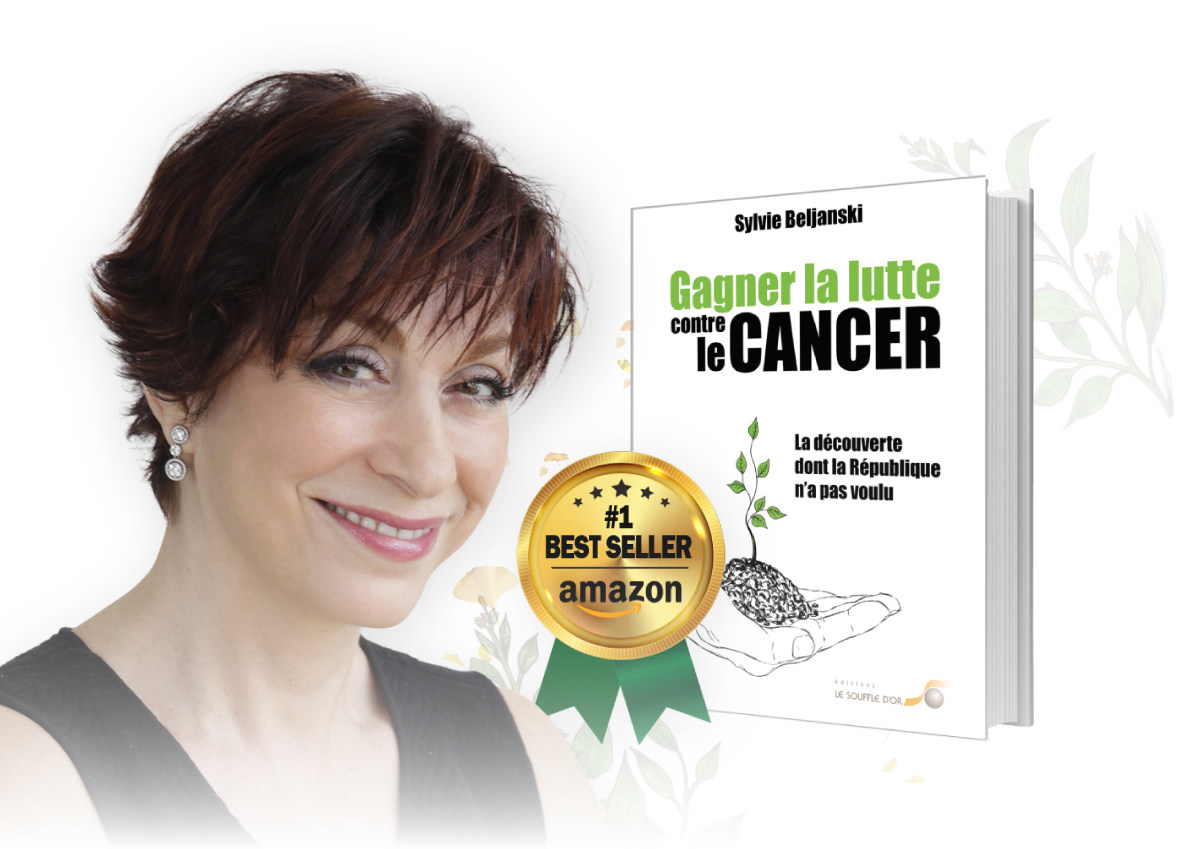93 – Agonist and/or antagonists effects of plant hormones and an anticancer alkaloid on plant DNA structure and activity
IRCS Medical Science, 10, 1982, pp. 689-690.
Available in English only
ABSTRACT: Using a biochemical assay system (Oncotest) we have shown that DNAs from cancerous mammalian and plant cells are destabilized compared to DNA from healthy cells. Cancer DNAs susceptible to the action of carcinogens or other different compounds exhibit in vitro and in vivo a high template activity in comparison to DNAs from healthy cells. We have also shown that alstonine, a plant alkaloïd prepared in our laboratory which selectively binds to DNA from cancer cells prevents DNA in vitro synthesis as well as cancer cells in vivo multiplication in animals and plants. It has slight effect on DNA from healthy cells. We describe here the effects of auxin (IAA) and kinetin (K) (two cell growth and division hormones in higher plant species) and that of alstonine (BG-8) on in vitro synthesis and strand separation of DNAs isolated from cancerous, habituated and healthy plant cells cultures in vitro.
ABSTRACT: Using a biochemical assay system (Oncotest) we have shown that DNAs from cancerous mammalian and plant cells are destabilized compared to DNA from healthy cells. Cancer DNAs susceptible to the action of carcinogens or other different compounds exhibit in vitro and in vivo a high template activity in comparison to DNAs from healthy cells. We have also shown that alstonine, a plant alkaloïd prepared in our laboratory which selectively binds to DNA from cancer cells prevents DNA in vitro synthesis as well as cancer cells in vivo multiplication in animals and plants. It has slight effect on DNA from healthy cells. We describe here the effects of auxin (IAA) and kinetin (K) (two cell growth and division hormones in higher plant species) and that of alstonine (BG-8) on in vitro synthesis and strand separation of DNAs isolated from cancerous, habituated and healthy plant cells cultures in vitro.
92 – Selective Inhibition of in vitro Synthesis of Cancer DNA by Alkaloids of ß-Carboline Class
Expl. Cell. Biol., 50, 1982, pp. 79-87
Available in English only
ABSTRACT: The high template in vitro activity of native DNA from cancerous mammalian and plant tissues, compared to DNA from healthy tissues, enabled us to select substances which selectively inhibit cancer DNA synthesis. Among them, alstonine, serpentine, sempervirine and flavopereirine, all alkaloids which belong to the Beta-carboline class, distinguish cancer DNA from healthy tissue DNA inhibit DNA in vitro synthesis when native DNA from different cancerous tissues or cells is used as template. They have practically no effect on DNA from healthy tissues. The inhibitory effect of alkaloids is due to their capacity to form an ‘alkaloid-cancer DNA’ complex which has been characterized by use of the Sephadex column. Evidence is presented showing that these alkaloids inhibit the initiation of DNA synthesis but not chain elongation. The stimulating action caused by carcinogens during cancer DNA in vitro synthesis may be prevented and reversed by alkaloids. Furthermore, the stimulating action of steroids during in vitro synthesis of hormone target tissue DNA might be neutralized by alkaloids. However, at relatively high doses, steroids reversibly compete with alkaloids for binding sites on breast cancer DNA. This is not observed with DNA from nonhormone target tissues.
ABSTRACT: The high template in vitro activity of native DNA from cancerous mammalian and plant tissues, compared to DNA from healthy tissues, enabled us to select substances which selectively inhibit cancer DNA synthesis. Among them, alstonine, serpentine, sempervirine and flavopereirine, all alkaloids which belong to the Beta-carboline class, distinguish cancer DNA from healthy tissue DNA inhibit DNA in vitro synthesis when native DNA from different cancerous tissues or cells is used as template. They have practically no effect on DNA from healthy tissues. The inhibitory effect of alkaloids is due to their capacity to form an ‘alkaloid-cancer DNA’ complex which has been characterized by use of the Sephadex column. Evidence is presented showing that these alkaloids inhibit the initiation of DNA synthesis but not chain elongation. The stimulating action caused by carcinogens during cancer DNA in vitro synthesis may be prevented and reversed by alkaloids. Furthermore, the stimulating action of steroids during in vitro synthesis of hormone target tissue DNA might be neutralized by alkaloids. However, at relatively high doses, steroids reversibly compete with alkaloids for binding sites on breast cancer DNA. This is not observed with DNA from nonhormone target tissues.
91 – Crown-gall Tumor Stimulation or Inhibition: Correlation with DNA Strand Separation
Proc. Fifth Int. Conf. Plant Path. Bact. Cali, 1981, p. 295-307
Available in English only
ABSTRACT: The effects of the carcinogen dimethylbenz (a)anthracene, of antimitotic drugs (cyclophosphamide and daunorubicin), of the plant hormone (auxin IAA) and the antimitotic mitomycin C were investigated in vitro on cancer and healthy DNA from pea seedings, inoculated or not, with oncogenic agrobacterium tumefaciens. These substances stimulate in vitro both synthesis and strand separation of Crown-gall DNA as well as oncogenic A. tumefaciens DNA, while they have little effect on normal plant DNA as is the case with E.coli and non-oncogenic A. tumefaciens DNA. This correlates with the substance-enhancing-power on in vivo Crown-gall cell multiplication. Growth-stimulatory or inhibitory-effects are antagonized by the tumorless action of E. coli small size RNA-fragments. Plant ribonuclease is under control of all these compounds and the RNA-fragments compensate for increased or decreased ribonuclease activity induced by cyclophosphamide, daunorubicin, dimethylbenz(a) anthracene or auxin. There appears to be a correlation between ribonuclease activity and Crown-gall cell development.
ABSTRACT: The effects of the carcinogen dimethylbenz (a)anthracene, of antimitotic drugs (cyclophosphamide and daunorubicin), of the plant hormone (auxin IAA) and the antimitotic mitomycin C were investigated in vitro on cancer and healthy DNA from pea seedings, inoculated or not, with oncogenic agrobacterium tumefaciens. These substances stimulate in vitro both synthesis and strand separation of Crown-gall DNA as well as oncogenic A. tumefaciens DNA, while they have little effect on normal plant DNA as is the case with E.coli and non-oncogenic A. tumefaciens DNA. This correlates with the substance-enhancing-power on in vivo Crown-gall cell multiplication. Growth-stimulatory or inhibitory-effects are antagonized by the tumorless action of E. coli small size RNA-fragments. Plant ribonuclease is under control of all these compounds and the RNA-fragments compensate for increased or decreased ribonuclease activity induced by cyclophosphamide, daunorubicin, dimethylbenz(a) anthracene or auxin. There appears to be a correlation between ribonuclease activity and Crown-gall cell development.
90 – Differential susceptibility of cancer and normal DNA templates allows the detection of carcinogens and anticancer drugs
European Organization for Research on Treatment of Cancer
Third NCI-EORTC Sympmposium on new drugs in Cancer therapy, Institut Bordet, Bruxelles, 1981.
Available in English only
ABSTRACT: Based on the differential template activity exhibited by DNA isolated from cancerous and healthy human or animal tissues, the Oncotest is an accurate and rapid assay for the screening of carcinogenic compounds. Thus, in the presence of all necessary components for radioactive DNA synthesis by DNA polymerase, carcinogenic compounds, antimitotic drugs (and miscellaneous compounds), at given concentrations strongly stimulate the synthesis of DNA isolated from different cancer tissues, but only slightly enhance that of DNA from healthy tissues. Those carcinogens which cannot be characterized as mutagens in the Salmonella assay system, behave as carcinogens in the Oncotest. Carcinogenic potential of steroids can be shown by using the DNA from steroid hormone target tissue. There exists a common molecular mechanism through which carcinogens stimulate cancer DNA in vitro synthesis. Cancer DNAs are destabilized and in the presence of carcinogenic substances there is further DNA strand separation which accounts for the enhanced DNA synthesis. A correlation between in vitro cancer DNA synthesis, DNA strand separation and in vivo multiplication of cancerous cells can be demonstrated. Our assay system allows to detect those substances which selectively inhibit cancer DNA synthesis without affecting, in an appreciably way, that of DNA from healthy tissues.
ABSTRACT: Based on the differential template activity exhibited by DNA isolated from cancerous and healthy human or animal tissues, the Oncotest is an accurate and rapid assay for the screening of carcinogenic compounds. Thus, in the presence of all necessary components for radioactive DNA synthesis by DNA polymerase, carcinogenic compounds, antimitotic drugs (and miscellaneous compounds), at given concentrations strongly stimulate the synthesis of DNA isolated from different cancer tissues, but only slightly enhance that of DNA from healthy tissues. Those carcinogens which cannot be characterized as mutagens in the Salmonella assay system, behave as carcinogens in the Oncotest. Carcinogenic potential of steroids can be shown by using the DNA from steroid hormone target tissue. There exists a common molecular mechanism through which carcinogens stimulate cancer DNA in vitro synthesis. Cancer DNAs are destabilized and in the presence of carcinogenic substances there is further DNA strand separation which accounts for the enhanced DNA synthesis. A correlation between in vitro cancer DNA synthesis, DNA strand separation and in vivo multiplication of cancerous cells can be demonstrated. Our assay system allows to detect those substances which selectively inhibit cancer DNA synthesis without affecting, in an appreciably way, that of DNA from healthy tissues.
89 – Comparative study of Escherichia coli endotoxin, hydrocortisone and Beljanski leukocyte restorer activity in cyclophosphamide-treated rabbits
Proc. of the Soc. for Exp. Biol. and Med., 168, 1981, pp. 408-413
Available in English only
ABSTRACT: The leukopoietic activity of Beljanski leukocyte restorer(s) (BLR(s)) (RNA-fragments obtained from Escherichia coli rRNA), E; coli endotoxin, and hydrocortisone administrated iv was compared in rabbits treated daily with high doses of cyclophosphamide (CP), a drug which decreases the circulating leukocyte count. Results showed that endotoxin and hydrocortisone responses, characterized essentially by granulocytosis occured at the 48th hour and remained, even during daily CP administration, within physiological limits for 3-5 days. No tolerance was induced with by administration of BLR in normal rabbits, even after 11iv injections, implying no depletion of bone marrow cells. In contrast, repeated endotoxin injections led to febrile and leukocytic tolerance. In addition, BLR induced normal leukocytosis and a biphasic fever response in endotoxin-tolerant animals. When BLR and endotoxin were mixed and administrated every day to rabbits, the animal became tolerant to endotoxin but gave a normal fever and leukocyte response to BLR, even after the 14th injection. The imbalance induced by CP administration in the granulocyte/lymphocyte ratio may be corrected following an injection of BLR. These data showed that the physiological activity of BLR in leukopoiesis was clearly distinguishable from that manifested by E. coli endotoxin and in the second instance by hydrocortisone.
NB : today, these extracts are named Realbuild
ABSTRACT: The leukopoietic activity of Beljanski leukocyte restorer(s) (BLR(s)) (RNA-fragments obtained from Escherichia coli rRNA), E; coli endotoxin, and hydrocortisone administrated iv was compared in rabbits treated daily with high doses of cyclophosphamide (CP), a drug which decreases the circulating leukocyte count. Results showed that endotoxin and hydrocortisone responses, characterized essentially by granulocytosis occured at the 48th hour and remained, even during daily CP administration, within physiological limits for 3-5 days. No tolerance was induced with by administration of BLR in normal rabbits, even after 11iv injections, implying no depletion of bone marrow cells. In contrast, repeated endotoxin injections led to febrile and leukocytic tolerance. In addition, BLR induced normal leukocytosis and a biphasic fever response in endotoxin-tolerant animals. When BLR and endotoxin were mixed and administrated every day to rabbits, the animal became tolerant to endotoxin but gave a normal fever and leukocyte response to BLR, even after the 14th injection. The imbalance induced by CP administration in the granulocyte/lymphocyte ratio may be corrected following an injection of BLR. These data showed that the physiological activity of BLR in leukopoiesis was clearly distinguishable from that manifested by E. coli endotoxin and in the second instance by hydrocortisone.
NB : today, these extracts are named Realbuild
88 – Correlation between in vitro DNA Synthesis, DNA Strand Separation and in vivo Multiplication of Cancer Cells
Expl. Cell. Biol., 49, 1981, pp. 220-231.
Available in English only
ABSTRACT: The chemicals 9, 10-dimethylbenzanthracene (DMBA), ethionine, daunorubicin, actinomycin D, 1-(2-chloroethyl-1)-nitrosourea (CCNU), steroids, croton oil and dimethyl-sulfoxide (DMSO) were used in order to correlate their effect on the in vitro synthesis of normal and cancer DNA, on DNA strand separation and on accelerated in vivo multiplication of cancer cells. All of the compounds tested strongly stimulate the synthesis of cancer DNA in vitro catalyzed by DNA-dependent DNA polymerase I and measured as an acid-precipitable labeled product. Under the same conditions, the synthesis of DNA originating from healthy tissues is only slightly enhanced, except in the case of croton oil and DMSO. These substances are almost equally active on cancer and normal DNA. Although both cancer and normal DNA contain a large amount of double-stranded regions, the extent of DNA strand separation measured by the increase in UV absorbance (hyperchromicity) in the presence of each compound tested is much higher for all cancer DNA than for corresponding normal DNA. In contrast, DMSO and croton oil do not appear to distinguish cancer DNA from normal DNA. Additive and differential effects of various compounds on cancer DNA strand separation can be observed. Small doses of DMBA and CCNU stimulate the multiplication of Ehrlich ascites tumor cells in vivo in mice. There is thus a possible correlation between DNA strand separation, DNA synthesis, multiplication and differentiation of cancer cells in the presence of the above compounds, which is different from the response of normal cells to these compounds.
ABSTRACT: The chemicals 9, 10-dimethylbenzanthracene (DMBA), ethionine, daunorubicin, actinomycin D, 1-(2-chloroethyl-1)-nitrosourea (CCNU), steroids, croton oil and dimethyl-sulfoxide (DMSO) were used in order to correlate their effect on the in vitro synthesis of normal and cancer DNA, on DNA strand separation and on accelerated in vivo multiplication of cancer cells. All of the compounds tested strongly stimulate the synthesis of cancer DNA in vitro catalyzed by DNA-dependent DNA polymerase I and measured as an acid-precipitable labeled product. Under the same conditions, the synthesis of DNA originating from healthy tissues is only slightly enhanced, except in the case of croton oil and DMSO. These substances are almost equally active on cancer and normal DNA. Although both cancer and normal DNA contain a large amount of double-stranded regions, the extent of DNA strand separation measured by the increase in UV absorbance (hyperchromicity) in the presence of each compound tested is much higher for all cancer DNA than for corresponding normal DNA. In contrast, DMSO and croton oil do not appear to distinguish cancer DNA from normal DNA. Additive and differential effects of various compounds on cancer DNA strand separation can be observed. Small doses of DMBA and CCNU stimulate the multiplication of Ehrlich ascites tumor cells in vivo in mice. There is thus a possible correlation between DNA strand separation, DNA synthesis, multiplication and differentiation of cancer cells in the presence of the above compounds, which is different from the response of normal cells to these compounds.
87 – Short chain RNA fragments as promoters of leucocyte and platelet genesis in animals depleted by anti-cancer drugs
In the Role of RNA in Development and Reproduction.
Sec. Int. Symposium, april 25-30, 1980, pp.79-113.
Science Press Beijing. M.C. Niu and H.H. Chuang Eds Van Nostrand Reinhold Company.
Article not available online
Article not available online
86 – Oligoribo-nucleotides, promoters of leucocyte and platelet genesis in animals depleted by anticancer drugs
NCI-EORTC Symposium on nature, prevention and treatment of clinical toxicity of anticancer agents.
Institut Bordet, Bruxelles, 1980
Article not available online
Article not available online
85 - Cancer/anti-cancer dual action drugs in crown-gall tumors
IRCS Medical Science, 1979, 7, p. 475.
Available in English only
ABSTRACT: Parallel studies on plant and animal tumor sytems provide insight into the basic cellular mechanisme of tumorogenesis. In the laboratory animals, drugs characterized as mutagens with the Salmonella assay system, as for example cyclophosphamide, may have an antimitotic effect and/or give rise to neoplasms. Various other in vitro carcinogen screening tests have shown that cyclophosphamide and daunorubicin have mutagenic and carcinogenic potencies. We give here a brief summary of the effect of two anticancer drugs, cyclophosphamide (Endoxan) and daunorubicin, on the heritable cellular change in pre-induced Crown-gall tumor development.
ABSTRACT: Parallel studies on plant and animal tumor sytems provide insight into the basic cellular mechanisme of tumorogenesis. In the laboratory animals, drugs characterized as mutagens with the Salmonella assay system, as for example cyclophosphamide, may have an antimitotic effect and/or give rise to neoplasms. Various other in vitro carcinogen screening tests have shown that cyclophosphamide and daunorubicin have mutagenic and carcinogenic potencies. We give here a brief summary of the effect of two anticancer drugs, cyclophosphamide (Endoxan) and daunorubicin, on the heritable cellular change in pre-induced Crown-gall tumor development.
84 – Oncotest: a DNA assay system for the screening of carcinogenic substances
IRCS Medical science, 1979, 7, pp. 476.
Available in English only
ABSTRACT: We describe a very rapid, sensitive and economic assay system (Oncotest) using purified DNA(s) from both cancerous and healthy human tissues (lung, breast, ovary and brain) and DNA dependent-DNA polymerase I, partly purified from Escherichia coli for detecting potential carcinogens. The amount of in vitro synthesized radioactive DNA as acid precipitable product is measured under strictly identical experimental conditions in the absence or presence of various concentrations of coumpounds to be screened. All known carcinogens and several drugs we tested strongly stimulate the syntheses of cancer DNA and only slightly that of DNA from healthy tissues. The results can be obtained within 1 to 4 hours.
ABSTRACT: We describe a very rapid, sensitive and economic assay system (Oncotest) using purified DNA(s) from both cancerous and healthy human tissues (lung, breast, ovary and brain) and DNA dependent-DNA polymerase I, partly purified from Escherichia coli for detecting potential carcinogens. The amount of in vitro synthesized radioactive DNA as acid precipitable product is measured under strictly identical experimental conditions in the absence or presence of various concentrations of coumpounds to be screened. All known carcinogens and several drugs we tested strongly stimulate the syntheses of cancer DNA and only slightly that of DNA from healthy tissues. The results can be obtained within 1 to 4 hours.





